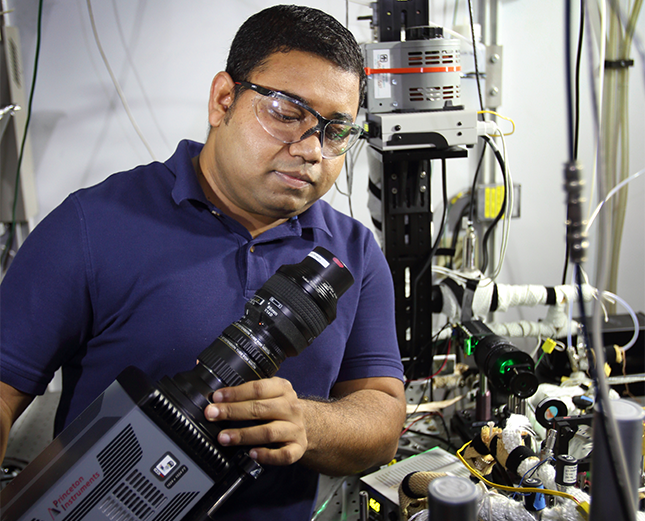UMN researchers' $10 plasma igniter produces zero emissions and doubles fuel economy

Photo credits: Office of the Vice President for Research, University of Minnesota
CSE professor invents spark plug alternative that leaves no carbon footprint
April 21, 2022
With more than one billion vehicles operating daily and millions of flights taking off annually, transportation is responsible for nearly one-third of the world’s greenhouse gas emissions and is a major contributor to global warming and climate change. While electric transportation can offset a fraction of toxic greenhouse emissions, batteries charging solely on clean electricity and environment-friendly battery recycling technology will take decades to mature. That's where Sayan Biswas comes in.
Biswas, the Benjamin Mayhugh Assistant Professor of Mechanical Engineering in the College of Science and Engineering at the University of Minnesota, is an experimental energy researcher who is deeply motivated by the fact that our current reliance on fossil fuels results in an alarming downward slope.
“That dangerous trajectory could take us to the point of no return as we’re adding more greenhouse gases and the planet is warming up,” he explained.
“There is a simple solution to this problem—adopt technologies that produce fewer or zero greenhouse gases. The question is, how do we develop clean energy technologies that can scale up to match our current gigantic energy demand?”
Plasma, the fourth state of matter after solids, liquids, and gases, is an ionized gas consisting of ions, electrons, and charged particles. One of Biswas’ solutions: An inexpensive, low-temperature plasma igniter that can replace conventional spark plugs, which are responsible for igniting the air and fuel mixture in combustion chambers to start engines in vehicles.
While traditional spark plugs produce a high-temperature spark, a low-temperature plasma igniter deposits a smaller and more precise amount of energy for ignition. And, plasma igniters can immediately be dropped into the existing engines at a cost of roughly $10, which could lead to hundreds of dollars in fuel savings while producing zero emissions and leaving no carbon footprint.
Biswas received the The U of M Office of the Vice President for Research's (OVPR) inaugural Innovation Impact Case Award for his project.
Technology catches up
The fact that plasma could be a powerful, more sustainable ignition source has been known for a while, but it has taken years for plasma technology to become viable for use in engines. Twenty years ago, plasma generators were the size of a room. Now they’re the size of a lunchbox, making it practical to install them in a typical engine.
Biswas collaborated with material scientists and electrical engineers from Sandia and Argonne National Laboratories to create a prototype plasma igniter. Because the original prototype cost $10,000, Biswas then worked with manufacturing experts to figure out ways to make the technology cost-effective.
“We measured the emissions and saw that nitrogen oxide emission, a significant contributor to greenhouse gases, is basically taken out of the picture because the engine is burning fuel at such a low temperature that it does not break nitrogen-nitrogen triple bonds, one of the strongest known chemical bonds,” Biswas said.
Through a series of lab-based engine experiments for a range of operating conditions, they found that plasma technology also dramatically improves fuel economy. An engine delivering 35 miles-per-gallon might achieve 60-70 miles-per-gallon with negligible pollutant emissions.
What’s next?
While the technology has been proven to work, Biswas and his team still need to know how durable it is before they begin installing plasma igniters in production engines. They are working with several engine manufacturers to conduct reliability and longevity testing of plasma igniters in their four and six-cylinder engines. If all goes well, Biswas envisions this technology could be included in all gas engines that use an igniter.
They are also developing synthetic carbon-neutral and carbon-negative fuels to replace fossil fuels, and exploring new research directions with plasma, such as plasma technologies in supersonic flights and plasma for renewable energy harvesting.
Biswas believes that humans can have a significant impact on climate change by making steady and sustained technological changes starting now.
“It’s like losing weight in that you have to do work every single day. You can’t just go to the gym once and run for 24 hours,” he said.
“You need a plan that includes healthy habits and a good diet. It’s painstaking, but if you do it consistently, it will get into your lifestyle. Similarly, every country, organization, and even every individual must have a climate action plan. We have to make small changes on a regular basis. We have to work together, and we must act now. I am motivated to give people technologies they can incorporate into their lifestyles. It is not too late to limit some of the worst effects of climate change.”
Story repurposed from the U of M Office of the Vice President for Research. Read the original story.
If you’d like to support research in the University of Minnesota College of Science and Engineering, visit our CSE Giving website.
